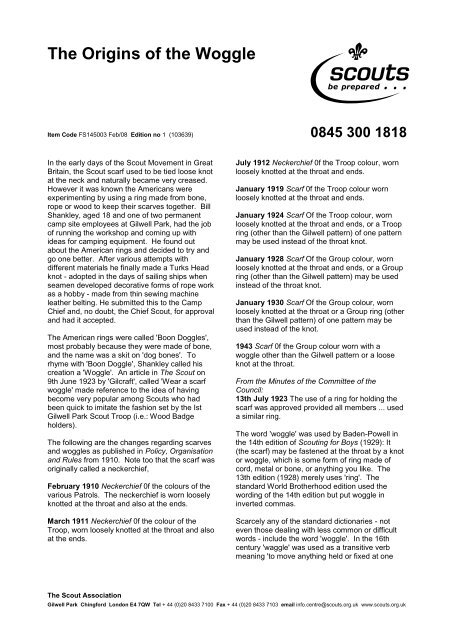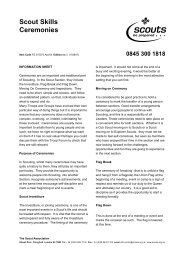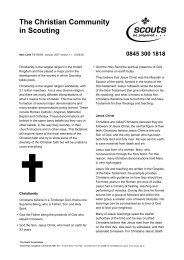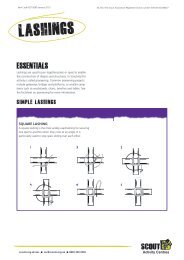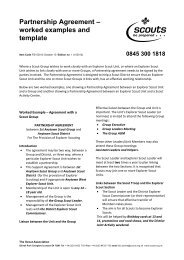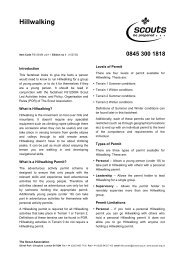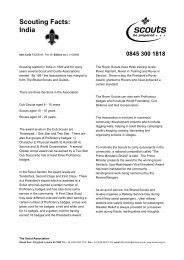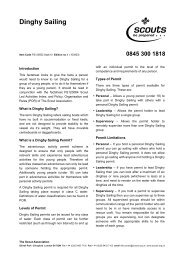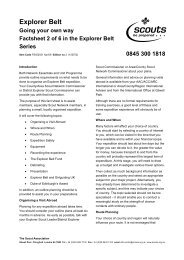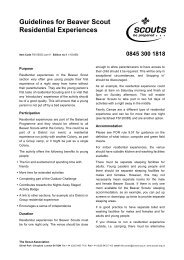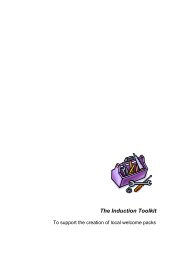The Origins of the Woggle - ScoutBase UK
The Origins of the Woggle - ScoutBase UK
The Origins of the Woggle - ScoutBase UK
Create successful ePaper yourself
Turn your PDF publications into a flip-book with our unique Google optimized e-Paper software.
<strong>The</strong> <strong>Origins</strong> <strong>of</strong> <strong>the</strong> <strong>Woggle</strong><br />
S<br />
Item Code FS145003 Feb/08 Edition no 1 (103639) 0845 300 1818<br />
In <strong>the</strong> early days <strong>of</strong> <strong>the</strong> Scout Movement in Great<br />
Britain, <strong>the</strong> Scout scarf used to be tied loose knot<br />
at <strong>the</strong> neck and naturally became very creased.<br />
However it was known <strong>the</strong> Americans were<br />
experimenting by using a ring made from bone,<br />
rope or wood to keep <strong>the</strong>ir scarves toge<strong>the</strong>r. Bill<br />
Shankley, aged 18 and one <strong>of</strong> two permanent<br />
camp site employees at Gilwell Park, had <strong>the</strong> job<br />
<strong>of</strong> running <strong>the</strong> workshop and coming up with<br />
ideas for camping equipment. He found out<br />
about <strong>the</strong> American rings and decided to try and<br />
go one better. After various attempts with<br />
different materials he finally made a Turks Head<br />
knot - adopted in <strong>the</strong> days <strong>of</strong> sailing ships when<br />
seamen developed decorative forms <strong>of</strong> rope work<br />
as a hobby - made from thin sewing machine<br />
lea<strong>the</strong>r belting. He submitted this to <strong>the</strong> Camp<br />
Chief and, no doubt, <strong>the</strong> Chief Scout, for approval<br />
and had it accepted.<br />
<strong>The</strong> American rings were called 'Boon Doggles',<br />
most probably because <strong>the</strong>y were made <strong>of</strong> bone,<br />
and <strong>the</strong> name was a skit on 'dog bones'. To<br />
rhyme with 'Boon Doggle', Shankley called his<br />
creation a '<strong>Woggle</strong>'. An article in <strong>The</strong> Scout on<br />
9th June 1923 by 'Gilcraft', called 'Wear a scarf<br />
woggle' made reference to <strong>the</strong> idea <strong>of</strong> having<br />
become very popular among Scouts who had<br />
been quick to imitate <strong>the</strong> fashion set by <strong>the</strong> Ist<br />
Gilwell Park Scout Troop (i.e.: Wood Badge<br />
holders).<br />
<strong>The</strong> following are <strong>the</strong> changes regarding scarves<br />
and woggles as published in Policy, Organisation<br />
and Rules from 1910. Note too that <strong>the</strong> scarf was<br />
originally called a neckerchief,<br />
February 1910 Neckerchief 0f <strong>the</strong> colours <strong>of</strong> <strong>the</strong><br />
various Patrols. <strong>The</strong> neckerchief is worn loosely<br />
knotted at <strong>the</strong> throat and also at <strong>the</strong> ends.<br />
March 1911 Neckerchief 0f <strong>the</strong> colour <strong>of</strong> <strong>the</strong><br />
Troop, worn loosely knotted at <strong>the</strong> throat and also<br />
at <strong>the</strong> ends.<br />
July 1912 Neckerchief 0f <strong>the</strong> Troop colour, worn<br />
loosely knotted at <strong>the</strong> throat and ends.<br />
January 1919 Scarf 0f <strong>the</strong> Troop colour worn<br />
loosely knotted at <strong>the</strong> throat and ends.<br />
January 1924 Scarf Of <strong>the</strong> Troop colour, worn<br />
loosely knotted at <strong>the</strong> throat and ends, or a Troop<br />
ring (o<strong>the</strong>r than <strong>the</strong> Gilwell pattern) <strong>of</strong> one pattern<br />
may be used instead <strong>of</strong> <strong>the</strong> throat knot.<br />
January 1928 Scarf Of <strong>the</strong> Group colour, worn<br />
loosely knotted at <strong>the</strong> throat and ends, or a Group<br />
ring (o<strong>the</strong>r than <strong>the</strong> Gilwell pattern) may be used<br />
instead <strong>of</strong> <strong>the</strong> throat knot.<br />
January 1930 Scarf Of <strong>the</strong> Group colour, worn<br />
loosely knotted at <strong>the</strong> throat or a Group ring (o<strong>the</strong>r<br />
than <strong>the</strong> Gilwell pattern) <strong>of</strong> one pattern may be<br />
used instead <strong>of</strong> <strong>the</strong> knot.<br />
1943 Scarf 0f <strong>the</strong> Group colour worn with a<br />
woggle o<strong>the</strong>r than <strong>the</strong> Gilwell pattern or a loose<br />
knot at <strong>the</strong> throat.<br />
From <strong>the</strong> Minutes <strong>of</strong> <strong>the</strong> Committee <strong>of</strong> <strong>the</strong><br />
Council:<br />
13th July 1923 <strong>The</strong> use <strong>of</strong> a ring for holding <strong>the</strong><br />
scarf was approved provided all members ... used<br />
a similar ring.<br />
<strong>The</strong> word 'woggle' was used by Baden-Powell in<br />
<strong>the</strong> 14th edition <strong>of</strong> Scouting for Boys (1929): It<br />
(<strong>the</strong> scarf) may be fastened at <strong>the</strong> throat by a knot<br />
or woggle, which is some form <strong>of</strong> ring made <strong>of</strong><br />
cord, metal or bone, or anything you like. <strong>The</strong><br />
13th edition (1928) merely uses 'ring'. <strong>The</strong><br />
standard World Bro<strong>the</strong>rhood edition used <strong>the</strong><br />
wording <strong>of</strong> <strong>the</strong> 14th edition but put woggle in<br />
inverted commas.<br />
Scarcely any <strong>of</strong> <strong>the</strong> standard dictionaries - not<br />
even those dealing with less common or difficult<br />
words - include <strong>the</strong> word 'woggle'. In <strong>the</strong> 16th<br />
century 'waggle' was used as a transitive verb<br />
meaning 'to move anything held or fixed at one<br />
<strong>The</strong> Scout Association<br />
Gilwell Park Chingford London E4 7QW Tel + 44 (0)20 8433 7100 Fax + 44 (0)20 8433 7103 email info.centre@scouts.org.uk www.scouts.org.uk
page 2 <strong>of</strong> 2<br />
end to and fro with short quick motions'. By <strong>the</strong><br />
following century 'woggle' had also come into use<br />
as a variation <strong>of</strong> 'waggle' but as a verb. By <strong>the</strong><br />
early 1900s 'woggle' had come to be used as a<br />
noun but it was not in standard usage.<br />
As for 'boon doggle', <strong>the</strong> Oxford English Dictionary<br />
states:<br />
US slang (origin unknown). A trivial, useless or<br />
unnecessary undertaking, wasteful expenditure.<br />
1935 - R. Marshall in New York Times 4 April:<br />
Boon doggles is simply a term applied back in<br />
pioneer days to what we call gadgets today.<br />
1935 - Word Study 2nd Sept.: Boon doggle was<br />
coined for ano<strong>the</strong>r purpose by Robert H. Link <strong>of</strong><br />
Rochester. Through his connection with Scouting<br />
<strong>the</strong> word later came into general use as a name<br />
given to <strong>the</strong> braided lea<strong>the</strong>r lanyard made and<br />
worn by Boy Scouts.<br />
Websters Dictionary says:<br />
Coined in 1925 by Robert H. Kink b. 1897 Am.<br />
Scoutmaster 'a handicraft article esp. <strong>of</strong> lea<strong>the</strong>r or<br />
wicker fashioned for utility'.<br />
<strong>The</strong> design <strong>of</strong> <strong>the</strong> Gilwell woggle (i.e.: that formed<br />
by a Turk's Head knot) and <strong>the</strong> wearing <strong>of</strong> it<br />
became restricted to leaders who had completed<br />
preliminary or basic training from 1943 until 1989<br />
when <strong>the</strong> structure <strong>of</strong> leader training was revised.<br />
As for <strong>the</strong> inventor <strong>of</strong> <strong>the</strong> woggle, in <strong>the</strong> 1920s Bill<br />
Shankley accompanied Sir Alfred Pickford, <strong>the</strong><br />
Headquarters Commissioner for Overseas<br />
Scouts, on an <strong>of</strong>ficial tour <strong>of</strong> Australia and New<br />
Zealand, and afterwards stayed on to try his hand<br />
jackerooing and farming in Western Australia. In<br />
1952 he moved to Hobart and became a trade<br />
and craft teacher at <strong>the</strong> Friends School before<br />
retiring to Bellerive in 1977.<br />
Archives Department<br />
<strong>The</strong> Scout Association


